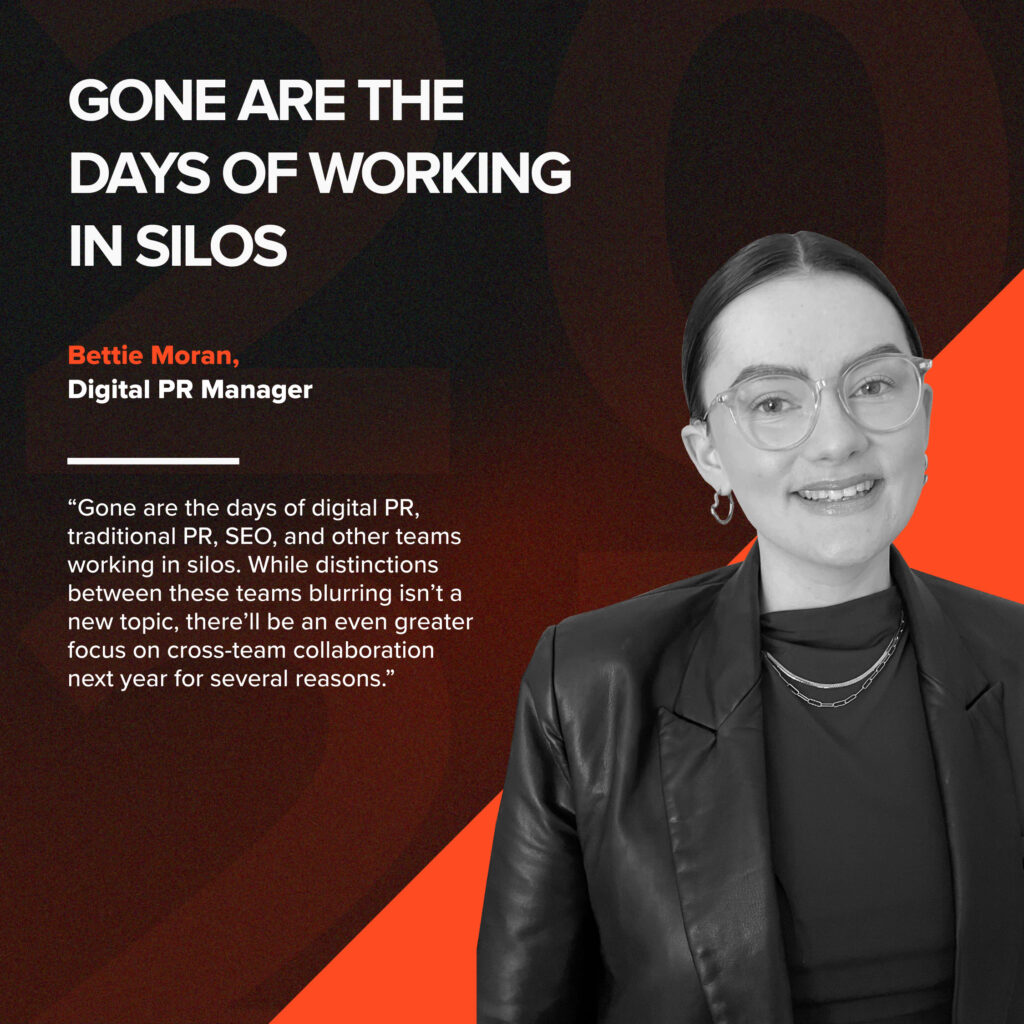
As we move into 2025, the pace of change in search marketing shows no signs of slowing down. With new challenges and opportunities on the horizon, staying ahead has never been more crucial.
Our team at Digitaloft has reflected on the successes of 2024 to share their top predictions for SEO, content and digital PR in the year ahead. From emerging trends to game-changing strategies, here’s what we expect to shape the industry in 2025.

Getting Intent, Information Gain, User Signals & Reputation Right Will be The Key to SEO Success in 2025
James Brockbank, Managing Director & Founder:
We’re entering—or perhaps already in—an era where more and more websites are doing well at the SEO fundamentals.
This means having a site free from technical growth blockers, creating user-first (dare I say helpful) content, and structuring the site to align with how people search.
But what gave you a competitive advantage a few years ago simply won’t cut it anymore.
In 2025, brands need to shift their focus beyond the basics to achieve SEO success, and this includes matching searcher intent with the right content, leveraging information gain to add real value for users, improving user signals, and building a strong reputation.
SEO is far from dead, but the strategies needed to drive meaningful success are evolving. The brands that understand this shift and double down on it will be the ones that come out ahead next year.

Relevance Will Continue to Dominate, Alongside Building Brand Awareness
Amy Irvine, Digital PR Director:
Relevance is going to continue to be key for 2025, but so is building your brand. Improving your brand awareness is one of the best things you can do to help your search visibility. Google is increasingly favouring brands with strong brand recognition.
Brands need to be creating relevant content that increases their reputation and authority, not just with search engines, but consumers too.
It’s more important than ever to show the impact of your digital PR activity beyond just “links”. It doesn’t matter about the volume of links, the DR or DA of links, whether they are follow or no follow, it matters about the impact those links are having.
It’s not digital PR anymore, it needs to be more traditional PR executed in a way to earn relevant links and build your brand.

Personal Branding Will be Crucial for Digital Marketers in 2025
Francessca Reynoldson, Marketing & Business Development Manager:
In 2025, personal branding will be more important than ever for digital PRs, SEOs and digital marketers alike, serving as a key differentiator in an increasingly competitive and crowded space.
But it’s not just about having an online presence, it’s about making an impression that lasts. The key to a powerful personal brand is not about being the loudest in the room though. Think of your personal brand as a digital handshake; it’s how you communicate your unique offering to your audience. Your personal brand bridges the gap between transactional interactions and meaningful, lasting relationships.
In 2025, consumers and collaborators will seek genuine, authentic connections, preferring to engage with real people rather than faceless entities or generic brands. Personal branding will no longer be optional – it will be a strategic necessity. Without it, even the best products and services risk getting lost in the noise.

Demonstrating The Wider Impact of Digital PR Will Continue to be a Priority
Chloe Bennett, Head of Digital PR:
There will be a continued focus on understanding how your digital PR strategy feeds into your wider SEO strategy, and therefore, the impact your digital PR efforts are having beyond just the link numbers.
Gone are the days when logging links and brand mentions alone was enough to show how effective your digital PR strategy was. Instead, we need to be showing how our strategy adds value to our client’s business, thinking about how we’re impacting keyword rankings, organic traffic, what pages we’re targeting, branded vs non branded search, how we’re closing link gaps to competitors, and ultimately how we’re impacting the bottom line.
With more and more cuts being made to businesses, we must showcase the wider impact of digital PR – especially when it comes to driving sales and increasing revenue for our clients.

Position 1 Might Not be Enough Anymore
Liv Day, SEO Lead:
In the last 12 months, we’ve seen such a shift in SERP presentation: we’ve seen the introduction of AI overviews, we’ve seen search intent shifts, and we’ve seen increasing prominence of SERP features such as map packs and organic shopping listings. And it looks like this trend is set to continue into 2025.
As a result, that traditional position 1 (for some queries, not all) isn’t quite as powerful as it once was – it’s been pushed down below the fold below all these other features.
This highlights the need for us to think beyond position 1. If a search for your target keyword is returning organic shopping listings at the top of the SERP, you need to be there. Make sure your Merchant Center is set up properly, optimise your PDPs, ensure your structured data is top-notch – all of these things will help boost your visibility in those all-important top spaces.
These SERP features are giving brands the opportunity to appear on the first page of Google multiple times in multiple different formats – our job is to make sure we take those opportunities.

The C-suite Will Continue Pushing a “Do More With Less” Mentality, But This Doesn’t Mean Prioritising Quantity Over Quality.
Ellie Wraith, Content Lead:
In 2025, content marketing will be shaped by a growing demand from business leaders for teams to “do more with less.” But this isn’t about churning out more blog posts, whitepapers, PR campaigns, or social media updates. Instead, it’s a call to achieve more meaningful results – better engagement, stronger ROI, and higher-quality leads – by working smarter, not harder.
AI tools will undoubtedly remain central, but their use will shift. Rather than simply automating mass content production, successful teams will harness AI to supercharge research, streamline workflows, and personalise content. The focus will be on creating fewer, highly-targeted assets that resonate deeply with specific audiences.
This change will drive a renewed emphasis on strategy, data, and creativity. Teams will prioritise understanding their audience and leveraging insights to craft content that stands out amidst the noise. In short, the winners in 2025 won’t be the brands shouting the loudest – they’ll be the ones saying the most valuable things to the right people.
Content marketers and creators who embrace this shift will prove that “doing more with less” isn’t about cutting corners; it’s about cutting through the noise to make an intentional impact.

First-Hand Data Will Give Campaigns a Competitive Edge
Jamie Dixon, Content & Research Lead:
The digital PR landscape has become increasingly saturated, with campaigns often recycling the same public data from the same sources. This means that journalists will increasingly prefer campaigns grounded in unique, trustworthy data. Making use of their own first-hand data will allow brands to shape narratives around both trending and evergreen topics.
- Surveys: Whether using platforms like Google Surveys or surveying their own clients or customers, brands will increasingly use surveys to collect data specific to their audience and around super-relevant topics to their niche.
- Internal data: Brands will more often use their internal data for campaigns, analysing things like customer behaviour, buying trends, or usage statistics to uncover new insights.

Evolving Design For Mobile Audiences
Faye Baxter, Head of Design:
Designers will increasingly incorporate motion into their work to captivate audiences and enhance engagement. Graphics will be tailored to align with the consumption habits of mobile users, emphasising short-form, dynamic content over static visuals. This shift will make designs more interactive and immersive.
The focus on impactful communication will highlight striking statistics through concise, visually compelling short-form video formats. These formats will prioritise digestibility and memorability, ensuring key messages resonate with viewers.
This innovative approach to visual storytelling will complement longer-form content, maintaining viewer interest with standout data and compelling narratives. Incorporating voiceovers and audio elements into designs will further enrich these experiences, blending motion, sound, and interactivity for maximum impact.

Brand Mentions Will Begin to Become More Valuable Than Backlinks
Millie White, Senior Digital PR Manager:
Moving into 2025, digital PR will continue to be so much more than the volume of links we secure. Although links will continue to be valuable, we know that the industry is shifting and our focus is becoming more heavily weighted on the quality impact of our digital PR efforts, including our impact on the wider search landscape.
In 2024, we saw search engines rely more on mention information (brand mentions) to educate the system and this will continue to be true as we move into the new year. Brand mentions are quickly becoming the internet’s answer to word of mouth, acting as a vote of confidence in a brand, and allowing you to build further authority.
Ensuring your backlinks are linking to branded anchor text will also become even more vital in line with this (these are also brand mentions!). Over time, brand mentions will have a greater impact on organic visibility than the total number of links earned.

Expert Commentary Will be Key
Grace Burton, Senior Digital PR Executive:
Expert commentary will become even more crucial in 2025 with journalists increasingly seeking unique and authoritative voices to elevate their stories. Effectively leveraging your client’s expertise to deliver credible, insightful expert commentary that stands out will be essential to cut through the noise. Not only will this be key to securing media coverage, but it will also be crucial to build lasting relationships with journalists who will return for future insights. Dedicate some time to collaborate with your clients and create a comment bank with key industry insights. Having a resource like this will help you quickly access and share relevant quotes with journalists, ensuring timely responses to requests.
Brands will need to prioritise demonstrating E-E-A-T by focusing on both on-site and off-site strategies. Crafting high-quality and detailed author pages to establish credibility will be essential to complement off-site signals. This approach will help brands stand out and become trusted go-to sources for journalists, solidifying their authority in the industry.

Gone Are The Days of Working in Silos
Bettie Moran, Digital PR Manager:
The lines between digital PR, traditional PR, and other teams will become increasingly blurred in the face of economic challenges, relevancy, and alignment. Gone are the days of digital PR, traditional PR, SEO, and other teams working in silos. While distinctions between these teams blurring isn’t a new topic, there’ll be an even greater focus on cross-team collaboration next year for several reasons.
Reports say most brands plan to spend the same or more on their marketing activity, which is welcome news to our sector, but the rising cost of doing business means many company owners are still facing cost pressures. As a result, they may combine digital PR, traditional PR, and SEO efforts as a cost-efficiency exercise.
Relevancy is the latest buzzword in the marketing industry. Everyone’s talking about it, and what’s one way to make sure all marketing activity is relevant to what the brand actually does? Open communication between the PR teams and brand, product and sales teams and make sure everyone knows the company inside out.
Lastly, the key to a successful business strategy is for everyone to be on the same page about wider business goals. There’s no point in crafting perfect digital PR campaigns, lists of in-depth SEO recommendations, or social media strategies if any of the teams don’t know what they’re actually working towards. Fostering alignment across all departments will help businesses reach their goals faster, whatever they may be. Plus, consumers engage with brands across numerous touchpoints now, so making sure your messaging is consistent will help with brand reputation and customer loyalty.

We’ll Still Need to Consider The Cost of Living in Campaigns
Alex Minion, Digital PR Manager:
As the cost of living continues to soar, it’s important to factor this into our ideations in 2025, considering the campaigns and content we create for clients. This could mean extra sensitivity around the way we approach luxurious topics such as travel and shopping, which may appear unrelatable and out of touch to a majority of readers.
This can also be a way for clients to address these price increases within their niche, offering authoritative insights into the topic. Whether that’s a property client addressing rent and mortgage prices, or campaigns on car insurance, heating bills and overall living costs, rising prices are a huge talking point both in the media and in everyday life.
Campaigns which highlight these price increases and offer comparisons either regionally or globally are likely to be of interest to both journalists and readers, demonstrating social awareness and positioning the brand as a trusted voice in their niche.
As we step into 2025, the pace of change shows no signs of slowing. From unpredictable Google updates to shifting trends in tactics and a news agenda that refuses to sit still, last year’s challenges were just the beginning. 2025 promises new opportunities, fresh hurdles, and plenty of surprises. Let’s go!



